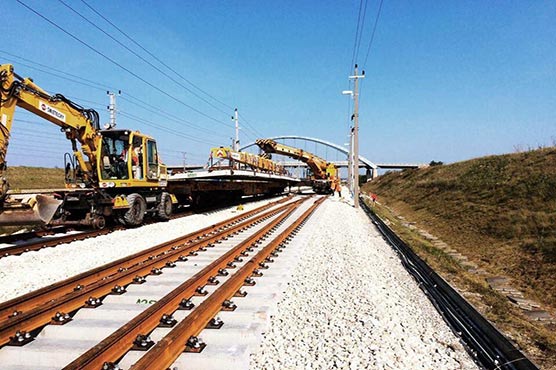By Manahil Khan

In first ten years of China-Pakistan Economic Corridor (CPEC), Pakistan and China have worked very closely to help rejuvenate the ailing economy of Pakistan. CPEC is designed to improve Pakistan’s infrastructure and connect it to other prongs of China’s Belt and Road Initiative (BRI).
The first phase of CPEC has already been completed and the second phase is now underway. ML1, a key prong of CPEC’s second phase, is a railway project that will upgrade and modernize Pakistan Railways. The project is financed by China, and the work will be carried out by Chinese companies. ML1 is the largest railway project in Pakistan, and it is a key part of the CPEC. The railway project will start in the Pakistani city of Karachi and end in the city of Peshawar.
ML1 is a railway project that will revive and redesign the construction of a 1,296km track running from Karachi to Peshawar. The project is a joint venture between Pakistan and China, and is expected to cost an estimated $8.2 billion. The ML1 project is a crucial part of the China Pakistan Economic Corridor, and will see the construction of a new railway line that runs from Karachi to Peshawar. The project is a joint venture between Pakistan and China, and is expected to cost an estimated $8.2 billion.
The new railway line will replace the existing Karachi-Peshawar Railway Line, which is over a hundred years old and in need of significant repairs. The new line will be built to modern standards and will be able to handle heavier and faster trains. It is expected to greatly reduce travel times between Karachi and Peshawar, and will also provide a much-needed boost to the economy of Pakistan. The ML1 project is a key part of the China Pakistan Economic Corridor, and its successful completion is essential for the future of Pakistan.
ML1 will pass through the towns of Hyderabad, Sukkur, Multan and Lahore. The total length of the railway line is 1,872 kilometers. The project will cost $8.2 billion, and it is scheduled to be completed by 2024. ML1 is a major infrastructure project that will have a transformative effect on Pakistan. When complete, it will improve Pakistan’s economy and connectivity.
As a key project the second phase of the China-Pakistan Economic Corridor (CPEC), ML1 is set to focus on the construction of a new mainline railway running from Karachi to Peshawar, via Islamabad. The project is a massive undertaking which is expected to take around five years to complete. Once complete, the new railway will significantly improve Pakistan’s transport infrastructure, making it easier and faster to move goods and people around the country.
In addition, the project is also expected to create thousands of new jobs, both during construction and when the railway is up and running. There are numerous other benefits of the ML1 project, including: – boosting Pakistan’s economy by increasing trade and investment; – improving connectivity between different parts of the country; – helping to reduce pollution and traffic congestion; – and providing a much-needed boost to the country’s ailing railway system.
ML1 project will be financed through a mix of debt and equity. The project’s total cost is estimated at $2.8 billion, with $1.6 billion to be financed through debt and $1.2 billion through equity. The project’s sponsors – China Communications Construction Company (CCCC) and China Railway Engineering Corporation (CREC) – will provide $600 million in equity, while the remaining $1.2 billion will be raised through debt financing. The project’s debt will be structured as a mix of post-completion and pre-completion financing.
The post-completion financing will consist of a $1.2 billion senior loan from a consortium of Chinese banks, to be repaid over a period of 10 years. The pre-completion financing will be provided by CCCC and CREC, and will be used to fund the project’s construction costs. The project’s sponsors have also committed to provide $400 million in contingent financing, to be used if the project experience any cost overruns or delays.
The CPEC Phase 2 ML1 project is a critical part of the Chinese government’s Belt and Road Initiative, and as such, is supported by a number of Chinese government institutions. The Export-Import Bank of China has committed to provide $1.2 billion in project financing, while the China Development Bank has committed to provide an additional $600 million.
The China-Pakistan Economic Corridor (CPEC) is a long-term infrastructure development project between the two countries. It is funded by the Chinese government and includes the construction of a rail link between the two countries, as well as other infrastructure projects. The ML1 project is the second phase of the CPEC project and is focused on the construction of a new rail link between Pakistan and China. The project is expected to cost $8.2 billion and is scheduled to be completed by 2025.
There are a number of challenges facing the ML1 project. Firstly, the financing of the project is still uncertain, with a number of lenders reluctant to commit to the project. Secondly, there are a number of environmental concerns surrounding the project, with critics arguing that the impact on the livelihoods of local communities has not been properly considered.
Thirdly, there is a risk that the project could lead to increased tensions between Pakistan and India, given the close proximity of the proposed route to the disputed territory of Kashmir. Finally, it is still unclear how the project will be managed and monitored, given the scale and complexity of the work involved.
As Pakistan and China enter the second phase of the China-Pakistan Economic Corridor project, it is important to understand the different aspects of the plan. The ML1 project is a crucial part of the CPEC initiative, and will have a major impact on the Pakistani economy. The ML1 project is a railway project that will improve Pakistan’s railway infrastructure. The project will upgrade existing railway lines, build new lines, and rehabilitate existing lines. The project is expected to cost $8.2 billion, and will be funded by the Chinese government.
The project is also important for China, as it will provide a faster and more efficient way to transport goods from China to Pakistan. The ML1 project is also important for regional connectivity, as it will improve transportation links between Pakistan and its neighbouring countries. The ML1 project is expected to have a major impact on the Pakistani economy.
The project is expected to create thousands of jobs, and will boost economic growth. The project will also improve Pakistan’s trade and investment prospects, and will attract foreign investment. The ML1 project is a major undertaking, and will have a significant impact on Pakistan. The project is crucial for Pakistan’s development, and will have a positive impact on the economy.
The first phase of CPEC was a great success and China is committed to continue its investment in Pakistan with the second phase. The second phase will focus on the development of Pakistan’s infrastructure, including the construction of a new ML1 railway line. This will create thousands of jobs and bring much needed investment to Pakistan. The second phase of CPEC is a great opportunity for Pakistan to further its development and improve its economy.
The author is a student at the NDU. She could be reached at [email protected]






















